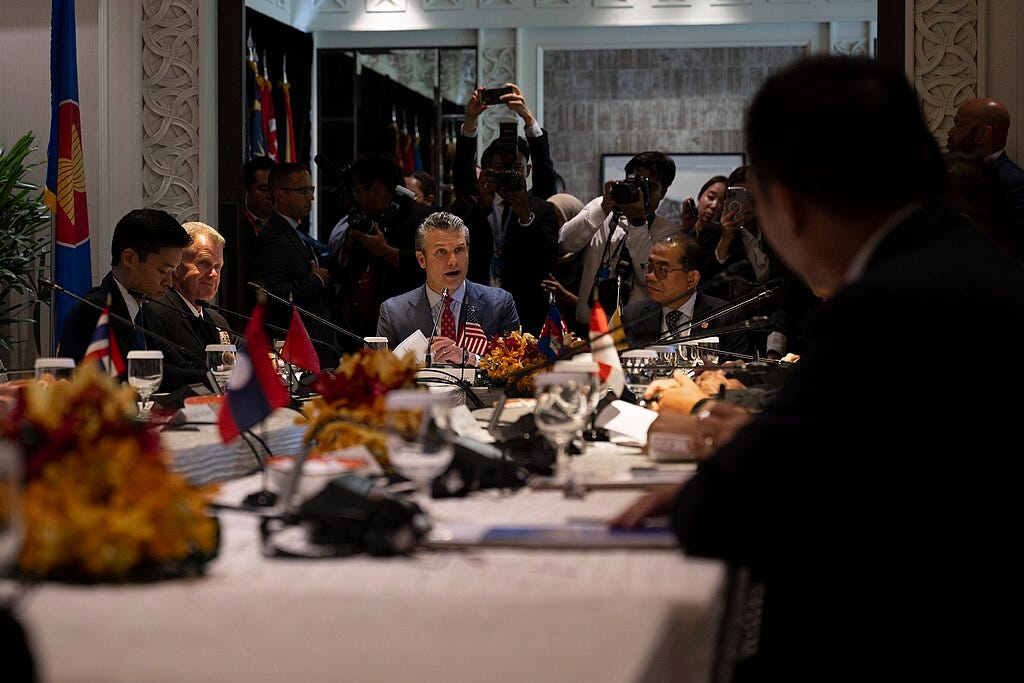Wei Zongyou is a professor at Fudan University’s Center for American Studies researching American security and foreign policy, American domestic politics, and U.S.-China relations. He is the author of In the Shadow of Hegemony: Strategic Choices, co-editor of several books on internationals relations, and author of dozens of articles.
Below is a speech he recently gave at a conference at Fudan University on the current Trump administration’s always difficult to discern policies in the Pacific. Although Wei seems some new elements compared to Trump’s first administration (most notably cuts to foreign aid), ultimately there is much that remains the same. This includes strong opposition to China’s influence in the region even if the U.S. is currently doing much to shoot itself in the foot with allies in East and Southeast Asia.
Thanks,
Nick

The Trump 2.0 Administration’s Indo-Pacific Strategy
On May 31, 2025, U.S. Secretary of Defense Pete Hegseth delivered a speech at the Shangri-La Dialogue, outlining the Trump 2.0 administration’s vision for the Indo-Pacific and explicitly identifying the primary threats the U.S. faces in the region, along with proposed policy actions.
Compared to the Indo-Pacific strategy during Trump’s first term, Hegseth’s remarks reveal several new features in the Trump 2.0 era:
First, a rejection of ideological preaching. Trump’s first-term strategy, branded as the "Free and Open Indo-Pacific," carried strong ideological overtones, framing U.S.-China competition as a clash between "freedom and authoritarianism" or "openness and repression." In contrast, Hegseth’s Shangri-La speech emphasized that the Trump 2.0 administration would avoid political or ideological lecturing, instead prioritizing national interests and cooperation based on "common sense and national interests" to maintain peace and protect commercial interests.
Second, a reluctance to spend on foreign aid. Hegseth’s speech made no mention of U.S. assistance to the Indo-Pacific, aligning with the more overt "America First" policy of Trump’s second term. The administration has significantly downsized the U.S. Agency for International Development (USAID) and imposed a 90-day freeze on all foreign aid. The proposed 2026 budget even plans to slash foreign aid by $30 billion. This marks a stark departure from Trump’s first term, when the Indo-Pacific initiative restructured the Overseas Private Investment Corporation (OPIC) into the U.S. International Development Finance Corporation (DFC) to counter China’s Belt and Road Initiative by boosting aid and infrastructure investments in Southeast Asia.
Third, demanding allies and partners to substantially increase defense spending and assume greater responsibilities. While Trump’s first term also pressured allies like Japan and South Korea to raise their burden-sharing for U.S. troop deployments, the second term has expanded this demand in three ways. One, requiring allies such as Japan and South Korea to increase defense spending to 3.5% of GDP. Two, enhancing military interoperability through frequent joint exercises and training to bolster collective combat readiness. Three, deepening collaboration with Japan, South Korea, Australia, and India in weapons development, production, maintenance, and logistics to address U.S. defense industrial shortfalls, particularly in naval, aerial, and missile capabilities.
Fourth, explicitly labeling China as a threat and vowing to prevent a forcible Taiwan reunification. While Trump’s first term framed China as a strategic competitor and geopolitical challenge, and the Biden administration avoided directly calling China a "threat," Hegseth’s speech openly branded China as a menace. He accused China of seeking regional hegemony, engaging in military expansion, harassing neighbors in the South China Sea, and attempting to seize Taiwan by force. Hegseth declared, "The China threat is real and could soon become imminent," pledging that the Trump administration would work with allies to build a "strong deterrent shield" to block any Chinese military action against Taiwan.
Despite these shifts, Trump 2.0’s Indo-Pacific strategy retains several key elements from the first term. Those key elements include: emphasizing the region’s strategic importance and affirming the U.S. as an Indo-Pacific nation; viewing China as the primary adversary in the region; prioritizing alliances and integrated deterrence to counter China; leveraging mini-lateral security frameworks like the Quad (U.S., Japan, India, Australia), AUKUS, and U.S.-Japan-Philippines or U.S.-Japan-Australia-Philippines groupings to constrain China.
However, the Trump 2.0 administration faces significant obstacles in advancing its Indo-Pacific strategy. The "America First" doctrine and erratic diplomacy undermine strategic credibility. Rising U.S. populism and transactional foreign policy have eroded allies’ trust in Washington as a reliable leader. Trump’s unpredictable style and policy swings leave partners frustrated and hesitant.
Deep cuts to foreign aid diminish U.S. appeal in the Pacific and Southeast Asia. Many nations in these regions have long sought greater U.S. assistance. The slashing of aid and USAID’s downsizing will damage America’s image, making it harder to rally support.
Transactional demands strain alliances. Even steadfast allies like Japan and Australia resent Trump’s pressure to shoulder more defense burdens while facing economic coercion. Other partners, including India, are disillusioned by Washington’s mercenary approach.
Trade wars alienate allies. Trump’s blanket tariffs and threats of economic retaliation—extended to allies like Japan, South Korea, and Southeast Asian states—spark resentment. His focus on trade deficits and coercive tactics also leaves the Indo-Pacific strategy without an economic pillar to attract cooperation.
In general, Trump 2.0’s Indo-Pacific strategy retains the first term’s hardline stance on China and reliance on alliances but sheds ideological rhetoric in favor of cost-benefit realism. Yet its emphasis on short-term gains, aid reductions, and cost-shifting risks undermines long-term U.S. influence. Balancing "America First" with alliance cohesion will be critical to the strategy’s success—or failure.
Wei Zongyou is a professor at the Center for American Studies, Fudan University.
The views expressed in this article represent those of the author(s) and not those of The Carter Center.
Peace is always on the back foot. To promote peaceful cooperation between the United States and China, all content from the Monitor is provided here for free. If you would like to contribute to our work, please feel free to make a donation to The Carter Center. Please indicate your donation is for China Focus.
That’s all from Atlanta. Y’all be good.




